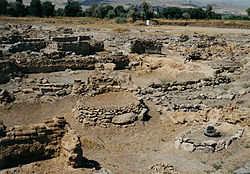Assoria
Assoria | |||||||||||
|---|---|---|---|---|---|---|---|---|---|---|---|
|
Symbol of Ashur, the ancient Assorian national deity | |||||||||||
| Capital | Assur | ||||||||||
| Official languages | |||||||||||
| Common languages | Akadian Aramaic | ||||||||||
| Demonym(s) | Assorian, Ashurian | ||||||||||
| Government | Monarchy | ||||||||||
| King | |||||||||||
| Historical era | Bronze Age | ||||||||||
• Established | 2500 BC | ||||||||||
• Disestablished | 600 BC | ||||||||||
| |||||||||||
| The Ancient Caelean Coast |
|---|
 |
| Regions and states |
| Archaeological periods |
| Languages |
| Literature |
| Mythology |
Assoria, also known as Ashuria, was an Alaian kingdom and empire on the Ancient Caelean Coast, which existed as early as the 25th century BCE (in the form of the city-state of Assur) until its collapse in 600 BCE. This vast period is divided into the Early Period (2500-1900 BCE), Old Assorian Kingdom (1900-1580 BCE), Middle Assorian Empire (1580-900 BCE) and Neo-Assorian Empire (900-600 BCE). From 600 BCE following the fall of the Neo-Assorian Empire until the 14th century AD, Assoria survived as a geopolitical entity dominated by foreign powers, including Babylonia and the Romanyan Empire.
Assoria was a Semitic-speaking nation. From the Early Period until beginning of the Middle Assorian Empire, the common language was the Assorian dialect of Akadian. Aramaic rose to prominence during the Neo-Assorian Empire.
Contents
Name
The name "Assoria" is derived from the original capital of the Assorian state, the ancient city of Assur, which dates back to c. 2500 BC. The city Assur shared the same name as the national deity Ashur.
Pre-history
In prehistoric times, the region that was to become known as Assoria was home to Neanderthal cultures. The Akadian-speaking people who would eventually found Assoria entered Alaia at some point during the late 4th millennium BCE (c. 3500–3000 BC), intermingling with the earlier Sumerian-speakers, who came from the north.
The city of c, among others, existed since before c. 2500 BCE, although it was ruled by other Sumerian city-states. According to the Biblical generations of Noah, in Genesis chapter 10, the city of Assur was founded by Ashur the son of Shem. However, the much older attested Assorian tradition itself lists the first king of Assoria as the 25th century BCE Tudia. It is highly likely that the city was named in honour of its patron Assorian god with the same name.
History
Early Period (2500–1900 BCE)
The city of Assur, with several other Assorian cities, were established by 2500 BC. They were likely initially Sumerian-dominated administrative centres. Little is known about the early history of the city-state of Assoria. The earliest Assorian king recorded was Tudia.
Akadian Empire (2300–2100 BCE)
During the Akadian Empire (2300–2100 BCE), the Assorians, like all Semitic Alaians as well as Sumerians, became subject to the dynasty of the city-state of Akad. The Sumerians were eventually absorbed into the Akadian (Assorian-Babillonian) population.
Assorian rulers were subject to Sargon the Great and his successors, and the city of Assur became a regional administrative center of the Empire. Assorian traders spread the use of writing in the form of the Alaian cuneiform script to Kavarda and the Zahjeddah. However, towards the end of the reign of Sargon, Assoria rebelled against him.
Ayreoshubic Empire (2100-1900 BCE)
The Akadian Empire was conquered by the Ayreoshubic Empire in 2100 BCE, so Assoria was under Ayreoshubic rule.
Old Assorian Kingdom (1900–1580 BCE)
Ushpia was the first fully independent king of Assoria and is traditionally held to have dedicated temples to the god Ashur in the city of the same name. In c. 1850 BCE, Pumarashur I came to the throne of Assoria and conducted building projects in Assur. Assoria began to expand trading colonies into the north. He also conducted military campaigns in southern Alaia, in conquest of city-states and to protect his fellow Akadian-speakers from incursions by Elamites and Amorites.
He was succeeded by the long reigning Erishum I (1825–1785 BCE) who is notable for one of the earliest examples of written legal codes. These policies were continued by the following kings. King Shamshiadad I (1670–1650 BC), although he claimed Assorian ancestry, is regarded as a foreign Amorite usurper by later Assorian tradition. However, he greatly expanded the Old Kingdom, incorporating the northern half of Alaia and much of the coast into his empire. After Ishmedagan I's death Assoria was reduced to vassalage by Hammurabi. The folowing three Assorian kings were subservient to Hammurabi, who also took ownership of Assorian trading colonies, thus bringing an end to the Old Assorian Kingdom in 1630 BCE.
Middle Assorian Empire (1580-900 BCE)
However, Babylonian rule proved short lived, with it rapidly collapsing after the death of Hammurabi c. 1590 BCE. An Assorian governor named Puzursin deposed a foreign Amorite puppet of the new Babylonian king. A king called Adasi (1550–1530 BCE) finally restored strength and stability to Assoria, ending the civil unrest that had followed the ejection of the Babylonians and Amorites.
There followed a long, prosperous and peaceful period in Assorian history from about 1500 to 1350 BCE. Mutiple rulers had peaceful and relatively uneventful reigns. Assoria entered a period of decline and civil unrest in which it lost much of its peripheral holldings. However, the command of several strong king led to the retaking of these territories by 1100 BCE. The Empire continued to gradually expand. In 1000 BCE, Assoria and Babylonia engaged in wars for about a century until Assoria conquered its rival in 900 BCE.
Neo-Assorian Empire (900-600 BCE)
Tiglathpileser III (r. 910–897 BC) consolidated and centralized the holdings of the empire while also warring with Babylonia. His military conquests more than doubled the extent of Assorian territory. The most significant conquests were the vassalization of the Caelean coast all the way to the Alaqan border and the 900 BCE conquest of Babylonia, which marks the beginning of the Neo-Assorian Empire.
The Empire reached the height of its size and power under the Sargonid dynasty, founded by Sargon II (r. 875–858 BCE). The 780 BCE conquest of Alaqa under Esarhaddon (785–772 BCE) brought Assoria to its greatest ever extent. After the death of Ashurbanipal (663–625 BCE), the Neo-Assorian Empire swiftly collapsed. One of the main reasons was the inability of the kings to resolve the consistent Babylonian revolts throughout Sargonid rule. The revolt of Babylon under Nabopolassar in 615 BCE led to the Babylonian conquest of the Assorian Empire. Assur was sacked in 605 BCE.
Later history
Despite many revolts, Assoria remained under Babylonian until the Neo-Babyonian Empire was conquered by the Tundren Empire in 500 BCE. It then was vassalized by the Tundrens who ruled Assoria until the Romanyan conquest of Alaia in 60 BCE. Assoria was part of the Romanyan province of Alaia under the Romanyans until 630 CE.
Culture
Languages
The ancient Assorians primarily spoke and wrote the Assorian language, a Semitic language closely related to Babylonian. Both Assorians and Babylonian are dialects of the Akadian language, though ancient authors considered them to be two separate languages. Assorian was written with cuneiform script.
Because the Assorians never imposed their language on foreign peoples who they conquered, languages other than Akadian were able to spread. The migration of Arameans into Assoria during the Middle Assorian period facilitated the spread of the Aramaic language. As the most widely spoken and mutually understandable of the Semitic languages, Aramaic grew in importance throughout the Neo-Assorian period and increasingly replaced the Assorian language. From the 8th century BCE onwards, Aramaic became the de facto lingua franca of the Neo-Assorian Empire, with Assorian becoming a language of the political elite.
The Sumerian language was used as a language of scholarship and culture, though only in written form.
Religion
The main Assorian deity was Ashur. Though the deity and city are commonly distinguished by modern historians by calling the god Ashur and the city Assur, both were inscribed in the same way in ancient times. In documents from the Old Assorian period, the city and god are often not clearly differentiated, which suggests that Ashur originated as a deified personification of the city. The other Alaian deities were organized in a hierarchy below Ashur, having their own roles and primary seats of worship. Assorian deities were generally also worshipped by Babylonians.
Ashur's role was flexible and changed with the changing culture and politics of the Assorians. In the Old Assorian period, Ashur was mainly regarded as a god of death and revival. Under the Middle and Neo-Assorian Empire, Ashur's role was altered to a god of war, who bestowed the Assorian kings with divine legitimacy and commanded the kings to expand Assoria through conquest.
Assorian religion was centered in temples that included a central shrine and statue. Temples typically had their own resources, land holdings, and hierarchically organized personnel. Unlike many other ancient empires, the Neo-Assorian Empire did not impose its culture and religion on conquered peoples. After the fall of the Neo-Assorian Empire, the Assorians continued to venerate Ashur and the rest of the pantheon, though without the Assorian state.





